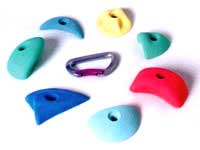|
|
|
|
|
A complete guide to modular holds - hold material |
|
|
| Plastic - most modular holds are some form of plastic such as polyurethane or polyester resin. Plastic may not be the best climbing medium but it can be easily poured into molds to duplicate specific climbing shapes. Plastic is also relatively strong and light so it is easy to see why so many hold companys are using it to make holds. Polyurethane resin tends to be more flexible than polyester resin which makes stronger holds.
The disadvantages of plastic is that it's not the best climbing medium. Plastic is softer than rock so with time the holds lose texture and polish. Plastic also doesn't "feel" like rock because it has a low heat capacity and thermal conductivity. Rock, as turns out is nearly the perfect climbing medium. It can remove heat from the hands and is good at staying cool. Heat is skin's worst enemy. It causes chaffing and turns up the volume on your skin's pain receptors. A really intense workout on plastic is not a pleasant experience.
|
|
|
|
 |
|
|
|
Plastic Holds |
|
|
|
Rock - rock holds are actual pieces of rock (granite, sandstone, limestone) that are converted into a modular hold by grinding one surface flat, and countersinking and drilling a hole for a mounting bolt. Advantages of rock holds are price (especailly in larger sizes), great climbing texture and feel (they are cool to the touch) and variety. Disadvantages of rock holds are that you can't specify shapes - you have to take what mother nature gives you. Also, you're simply not going to get certain useful shapes such as a two finger training pocket. |
|
|
| Ceramic - ceramic holds are made from fired clay. Most of these are shaped by hand. This doesn't result in true plastic hold shapes since it requires a long time to shape and get a smooth surface with clay. Economically, a ceramic hold manufacturer can't spend more than a few minutes shaping a hold. A plastic hold maker can spend hours getting a clay or foam origional perfect and then this is used as a master to make duplicates with a mold. Ceramic holds also tend to be rather thin. It is very difficult to make sections of a ceramic hold more than about an inch thick because of moisture removal problems. Ceramic holds don't polish as quickly as plastic holds and have a more rock-like feel. |
|
|
| Synrock - Synrock is a chemically bonded ceramic - although the best way to think of it is "artifical sandstone." Synrock is composed mainly of sand grains with an inorganic binding matrix. This matrix is slightly acid soluable so with an acid dip the texture is exactly the same as sandstone. Synrock holds are made in molds so they have shapes like plastic holds. Synrock is strong although somewhat brittle - they can chip if dropped on a hard surface. Synrock doesn't have any |
|
|
|
|
|
|
|
|
|
|
|
|
|
|
|

